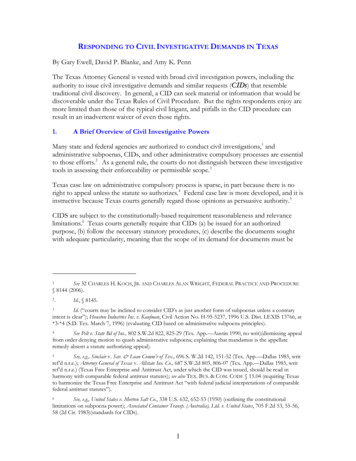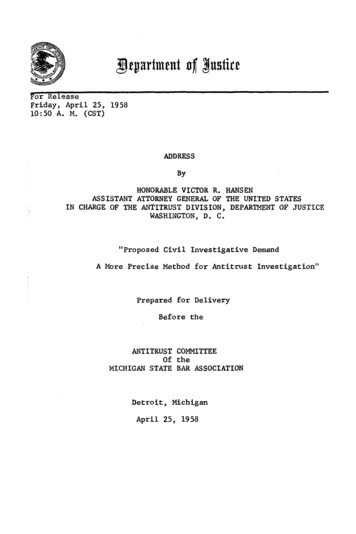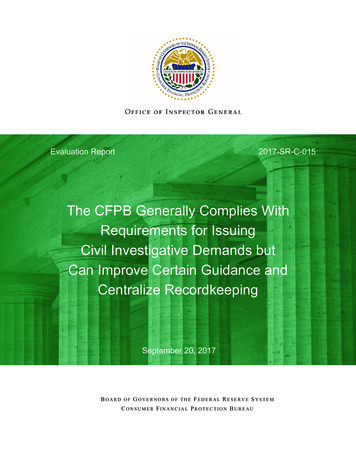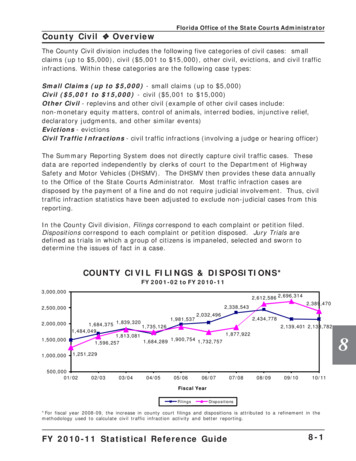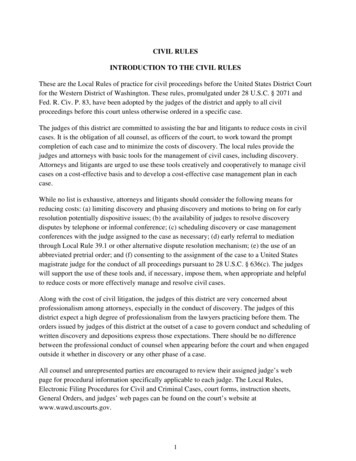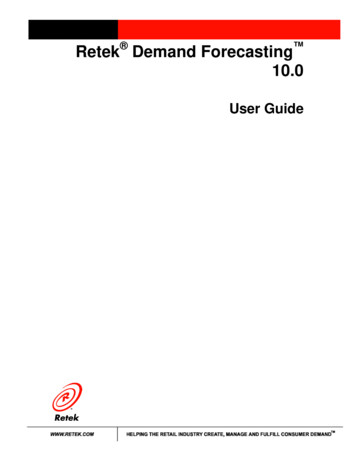
Transcription
CIVIL INVESTIGATIVE DEMANDFOR DOCUMENTS AND INFORMATIONUnless modified by agreement with the staff of the Department of Justice, eachspecification of this Civil Investigative Demand (“CID”) requires a complete search of yourcompany as defined in Paragraph A of the Definitions and Instructions that appear after thefollowing specifications. If your company believes that the required search or any other part ofthe CID can be narrowed in any way that is consistent with the Department’s need for documentsand information, you are encouraged to discuss such questions and possible modifications withthe Department representatives identified on the last page of this CID. All modifications to thisCID must be agreed to in writing by those representatives.SPECIFICATIONS1.Explain how (a)-(d) below affect Aetna’s business strategy and operations, includingAetna’s participation on the public exchanges related to the Affordable Care Act and anyproducts or geographic areas in which Aetna may withdraw or reduce operations:(a) A breakup or termination fee if the Proposed Transaction is not completed;(b) Financing costs associated with the Proposed Transaction if it is not completed;(c) Any other fees or costs related to the Proposed Transaction not being completed; and(d) The costs of litigation relating to the Proposed Transaction.2.Submit all documents relating to how specification 1(a)-(d) affect Aetna’s business strategyand operations, including Aetna’s participation on the public exchanges related to theAffordable Care Act and any products or geographic areas from which Aetna may withdrawor reduce operations.3.Submit all documents relating to the Aetna Board of Directors meeting on or about June 24,2016 (including all documents presented to the Board of Directors and any preparatorydocuments provided to any Board member or provided to or prepared by any personpresenting to the Board) and either the Proposed Transaction or the public exchanges relatedto the Affordable Care Act.DEFINITIONS AND INSTRUCTIONSFor the purposes of this CID, the following definitions and instructions apply:A. The terms “you,” “your company” or “Aetna” mean Aetna Inc., its domestic and foreignparents, predecessors, divisions, subsidiaries, affiliates, partnerships, and joint ventures, andall directors, officers, employees, agents, and representatives of the foregoing. The terms–1–
“parent,” “subsidiary,” “affiliate,” and “joint venture” refer to any person in which there ispartial (25 percent or more) or total ownership or control between your company and anyother person.B. The term “Affordable Care Act” means the Patient Protection and Affordable Care Act, 42U.S.C. § 18001 et seq. (2010), and any associated statutes, regulations, rules orinterpretations.C. The terms “and” and “or” have both conjunctive and disjunctive meanings.D. The term “documents” means all written, recorded, and graphic materials and all electronicdata of every kind in the possession, custody, or control of your company. The term“documents” includes electronic correspondence, drafts of documents, metadata, embedded,hidden and other bibliographic or historical data describing or relating to documents created,revised, or distributed on computer systems, and all duplicates of documents (whether or notidentical) in the files of or in the files maintained on behalf of all directors, officers,managers, or other supervisory employees, duplicates of documents in all other files that arenot identical duplicates of the originals, and duplicates of documents the originals of whichare not in the possession, custody, or control of your company. The term “documents”includes spreadsheets, as well as underlying cell formulae and other codes. The term“documents” also includes electronic mail messages and other documents and data stored in,or accessible through, computer or other information retrieval systems, such as personalcomputers, portable computers, workstations, minicomputers, personal data assistants,archival voice storage systems, group and collaborative tools, electronic messaging devices,portable or removable storage media, mainframes, servers, backup disks and tapes, archivedisks and tapes, and other forms of online or offline storage, whether on or off yourcompany premises. Unless otherwise specified, the term “documents” excludes bills oflading, invoices in non-electronic form, purchase orders, customs declarations, and othersimilar documents of a purely transactional nature and also excludes architectural plans andengineering blueprints.E. The term “including” means including but not limited to.F.The term “person” includes your company and means any natural person, corporate entity,partnership, association, joint venture, government entity, or trust.G. The term “relating to” means in whole or in part constituting, containing, concerning,discussing, describing, analyzing, identifying, or stating.H. The term “Proposed Transaction” means the proposed transaction between Aetna andHumana, as described in the company’s premerger notification, HSR-2015-1341.–2–
I.All references to year refer to calendar year. Each specification that calls for documentsrequires the company to submit all responsive documents that were created, altered, orreceived by the company after the date that is two years before the date of the issuance ofthis CID. Where information, rather than documents, is requested, provide it separately foreach year, or as specified. Where yearly data is not yet available, provide data for thecalendar year to date. If calendar year information is not available, supply your company’sfiscal year data indicating the twelve-month period covered, and provide your company’sbest estimate of calendar year data.J.The response to this CID must be submitted in the following manner:(1) Documents produced must be complete and, unless privileged, unredacted, submitted asfound in your company’s files (e.g., documents that in their original condition werestapled, clipped, or otherwise fastened together, or maintained in separate file folders,must be produced in such form). Documents submitted must be produced in the orderin which they appear in your company’s files and must not be shuffled or otherwiserearranged.(2) Your company may submit electronic copies (with color photocopies where necessaryto interpret the document) in lieu of original hard-copy documents.(3) Unless otherwise requested by a Department representative, electronic documents (e.g.,e-mail) and data must be produced in electronic form only. Electronic documents anddata must be produced in a format that allows the Department to access and use them,together with instructions and all other materials necessary to use or interpret the data,including record layouts and data dictionaries. For data submitted electronically,submit a description of the data’s source. For documents and data submittedelectronically, each electronic media device must be labeled so as to identify thecontents of that media device. For electronic media containing electronic documents,the label must state which custodian’s documents are contained on the device and thedocument control numbers of those documents.(4) Mark each page of each document submitted—whether in hard-copy or electronicformat—with corporate identification and consecutive document control numbers.Place all documents produced in hard-copy format in file folders. Mark each file folderwith your company’s identification, the name of the person whose documents are in thefolder and how the original file was labeled. Mark original documents with thedesignation “Original” and produce a list of all documents so designated. If yourcompany submits hard copies of electronic documents that have been printed from acommon electronic source, such as a central e-mail or document server or a backupdisk, such documents must be submitted in file folders that are marked with (a) a–3–
description of the enclosed documents’ electronic source (e.g., “Documents fromBackup Tape No. 3 for E-mail Server XYZ, 3/1/06-3/31/06”); and (b) the name of eachnatural person whose electronic documents are contained in that file folder.(5) In lieu of searching backup tapes or other media that are not reasonably accessible, butthat may contain information responsive to this CID, your company may elect toidentify and preserve for the duration of the Department’s investigation a select subsetof such backup and other media, such subset to be approved in writing by Departmentrepresentatives. In the event that Department representatives determine in their solediscretion that a search of the select subset of backup tapes is necessary, they must soinform your company, which will be required to conduct a review of the subset andproduce any responsive information contained therein.(6) Hard-copy documents must be submitted in sturdy boxes not larger than 1.5 cubic feet.Number each box and mark each box with corporate identification and the names of thepersons whose files are contained in that box.(7) Provide any index of documents prepared by any person in connection with yourresponse to this CID. If the index is available in electronic form, provide it in that form.(8) If you produce original documents they must be marked as described above inparagraph (4) of this Instruction. At the conclusion of the investigation, all documentsproduced in response to this CID that are not marked “Original” will be disposed of bythe Division. The documents will be returned to you only if you specifically requesttheir return at the time the documents are produced (unless the Division determines thatthey should be retained for a law-enforcement purpose or as required by the FederalRecords Act).K. Before you prepare documents or information for production in electronic form (forexample, before you attempt to copy, for your response to this CID, documents orinformation from an electronically stored source onto a disk or other electronic storagemedium), you must contact a Department representative to arrange a meeting or conferencecall with your company’s personnel who are familiar with the electronic files in which thedocuments or information are stored, to explain to Department representatives the manner inwhich the documents or information are stored, and the types of information that areavailable on the electronic source including all of the information identified in Instruction Lbelow. Department representatives must approve the format and production method forelectronic data in advance of the submission by your company of its response to this CID.Electronic productions must be scanned for and free of viruses. The Division will return anyinfected media for replacement, which may affect the timing of your company’s compliancewith this CID.–4–
L. Before your company or its agent uses software or technology to identify or eliminatepotentially responsive documents and information produced in response to this CID,including but not limited to search terms, predictive coding or similar technology, neardeduplication, deduplication, and email threading, your company must provide a detaileddescription of the methods used to conduct all or any part of the search. If search terms willbe used, in whole or in part, to identify documents and information that are responsive tothis CID, provide the following: (1) a list of the proposed search terms; (2) a word dictionaryor tally list of all the terms that appear in the collection and the frequency with which theterms appear in the collection (both the total number of appearances and the number ofdocuments in which each word appears); (3) a glossary of industry and your companyterminology; (4) a description of the search methodology (including the planned use of stemsearches and combination (or Boolean) searches); and (5) a description of the applicationsthat will be used to execute the search. The Department strongly recommends that yourcompany provide these items before conducting its collection of potentially responsiveinformation and consult with the Department to avoid omissions that would cause yourcompany’s response to be deemed deficient.M. Any documents that are withheld in whole or in part from production based on a claim ofprivilege must be assigned document control numbers (with unique consecutive numbers foreach page of each document); for purposes of this instruction, each attachment to adocument must be treated as a separate document and separately logged, if withheld, andcross referenced, if produced. Your company must also provide a statement of the claim ofprivilege and all facts relied upon in support of the decision to withhold each document, inthe form of a log that conforms with the requirements set forth below. Your company isencouraged to propose categorical limitations to exclude certain classes of privilegeddocuments from its log.(1) For each document identified on your company’s privilege log, state:(a) the document’s control number;(b) all authors of the document;(c) all addressees of the document;(d) all recipients of the document or of any copies of the document, to the extent notincluded among the document’s addressees;(e) the date of the document;(f) a description of the subject matter of the document;(g) the nature or type of the privilege that your company is asserting for the document(e.g., “attorney-client privilege”);(h) the specifications of this CID to which the document is responsive;–5–
(i) the document control numbers of any attachments to the document, regardless ofwhether any privilege is being asserted for such attachments; and(j) whether the document has been produced in redacted form.(2) Your company’s privilege log must also conform with all of the followingrequirements:(a) Provide a separate legend containing the full name, titles, and employer orcompany affiliation of each author, addressee, and recipient identified on yourcompany’s privilege log.(b) All attorneys acting in a legal capacity concerning the withheld document orcommunication, and only such attorneys, must be identified with the designationESQ on the privilege log (it is essential to have a space before and after the ESQ).(c) The description of the subject matter of each document must describe the nature ofthe document in a manner that, though not revealing information that is itselfprivileged, provides sufficiently detailed information to enable the Department toassess the applicability of the privilege claimed.(d) For each document withheld under a claim that it constitutes or contains attorneywork product, also state whether your company asserts that the document wasprepared in anticipation of litigation or for trial and, if so, identify the anticipatedlitigation or trial upon which the assertion is based.(e) Produce all nonprivileged portions of any responsive document (includingnonprivileged or redactable attachments) for which a claim of privilege is asserted,except where the only nonprivileged information in the document has already beenproduced. Note where any redactions in the document have been made.(f) The privilege log must be produced in both hard-copy and electronic form, theelectronic form of which must be both searchable and sortable.(g) Documents sent solely between counsel for your company, including in-housecounsel acting solely in a legal capacity, and documents authored by yourcompany’s outside counsel that were not directly or indirectly furnished to anythird party, such as internal law-firm memoranda, may be omitted from theprivilege log. However, any attachments to such documents must be included onthe privilege log (if a privilege is applicable to such materials), unless suchattachments are addressed and sent solely to counsel.N. If your company is unable to answer any question fully, supply such information as isavailable. Explain why such answer is incomplete, the efforts made by your company toobtain the information, and the source from which the complete answer may be obtained. Ifbooks and records that provide accurate answers are not available, enter best estimates and–6–
describe how the estimates were derived, including the sources or bases of such estimates.Estimated data should be followed by the notation “est.” If there is no reasonable way foryour company to make an estimate, provide an explanation.O. If documents responsive to a particular specification no longer exist for reasons other thanthe ordinary course of business or the implementation of your company’s documentretention policy, state the circumstances under which they were lost or destroyed, describethe documents to the fullest extent possible, state the specifications to which they areresponsive, and identify persons having knowledge of the content of such documents.P. For your company’s response to this CID to be complete, the certification on the reverse ofthe Civil Investigative Demand form must be executed by the official supervisingcompliance with this CID, notarized, and submitted along with the responsive materials.Any questions you have relating to this CID, including questions regarding its scope ormeaning, or suggestions for possible modifications, should be directed to Ryan Kantor at 202514-8430 or Patricia Sindel at 202-598-8300. To submit documents to the Department of Justicein response to this CID, address them to the attention of Ryan Kantor and deliver them to 450Fifth Street N.W., Suite 4100, Washington, DC 20530 between 8:30 a.m. and 5:00 p.m. on anybusiness day on or before the date of production specified on the CID form. To submit yourresponse by U.S. mail, please call the staff listed above for mailing instructions.–7–
CIVIL INVESTIGATIVE DEMAND FOR DOCUMENTS AND INFORMATION . Unless modified by agreement with the staff of the Department of Justice, each .



